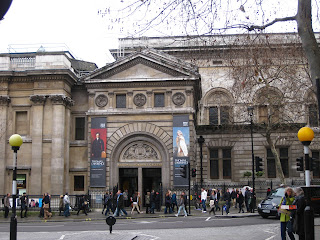 |
| Who? |
In the post about The Wellington Arch, we touched briefly on that period of British History known as ‘The Regency’. This was the period during which poor old George III (he who was on the throne – 1760 to 1820 -when England lost America in the War of Independence but gained Australia with the First Fleet). It was a crazy turbulent time, with the French Revolution having put everyone into a spin, and then years and years of wars between France and England culminating at last in Wellington’s great defeat of Napoleon at Waterloo (with the not inconsiderable help of Field Marshall von Blucher and everyone else in Europe).
 |
| Kew Palace, where poor George III spent his last days |
 |
| Regency days... |
George plunged extravagantly into so much debt that he had to go live with his secret wife at one point. George’s father had insisted on him marrying his cousin, Caroline of Brunswick, but they detested each other and lived apart (having first produced one daughter, Charlotte, who later died in childbirth at 21). George was a great dandy, and good friends with Beau Brummell. He was instrumental in establishing the Royal Academy, and Kings College London. The art, style, fashions and architecture of the period are known as ‘Regency Style’. The Times once wrote of George that he would always prefer "a girl and a bottle to politics and a sermon."
Sadly, the Regent’s dissolute lifestyle left him severely obese and possibly addicted to laudanum (we’d call him a heroin addict today). He also had very bad skin. He did, however, apparently have great hair. I deduce this from portraits of him by the premiere portrait painter of the Regency, Thomas Lawrence: a collection of whose paintings I visited today at the National Portrait Gallery. I popped into the exhibition to kill some time, but was immediately blown away by the pictures – so strong and vivid. Lawrence was said to be a great draughtsman, and the drawing skill is instantly evident. He also painted life-sized, full-length portraits in lively and sumptuous style.
Young Thomas was a prodigy from a humble background who took London by storm when only 21 years old. One of his early full length portraits that impressed the Academy and London society was a gorgeous one on display in the exhibition, of Queen Charlotte, the Regent’s mother, wife of George III and mother of his 15 children (the royal couple were said to be close. I think we can believe this). The Queen only gave Lawrence one sitting herself, but she allowed one of her ladies-in-waiting to model the Royal jewellery for him on a later occasion.
Lawrence soon acquired influential patrons and went on from strength to strength. He painted the actor Kemble, dressed in a toga playing Cato. After ‘The Big Win’ at Waterloo, the Regent sent Lawrence on a tour of Europe, painting all the famous and powerful who had collaborated to defeat the dreaded Napoleon, culminating in a very gentle portrait of Pope Pius VII, also in the exhibition.
 |
| The National Portrait Gallery on a grey Saturday in January |
Lawrence painted the Regent himself several times, and seems to have generally rendered him with the ‘High Romantic’ tousled hair-do I so admire. The Regent first consented to sit for Lawrence in 1814, when he had been Regent for three years. As a result of this introduction, Lawrence was knighted and became ‘Sir Thomas’, and was sent off on his continental foray. The painter was often criticised for overdoing it in his portraits of George, making them rather, er, complimentary and perhaps not quite faithful to life. The Regent was severely overweight and wore cosmetics to disguise his bad complexion.
I was quite thrilled at my introduction to Thomas Lawrence, of whom I was previously only dimly aware. The portraits in this exhibition are sumptuous and exciting. They, and their artist’s story, are also a fascinating snapshot of the Regency period, when Napoleon was defeated and The Prince Regent was doing his best to bankrupt the public purse. And here’s another interesting factoid: Lawrence’s home and studio was in Russell Square, Bloomsbury, and it was to his house on the Square that his famous sitters came for their portraits to be done. Clearly all the best artistic types favour Bloomsbury!
But to return to the Regent, who became George IV, it seems he was sadly unlamented when he died. The Times seems to have gone right off him by the end:
"There never was an individual less regretted by his fellow-creatures than this deceased king. What eye has wept for him? What heart has heaved one throb of unmercenary sorrow? ... If he ever had a friend — a devoted friend in any rank of life — we protest that the name of him or her never reached us."
If you are interested in more details about this larger-than-life character, here's an odd website that refers to him as 'Prinny'. Wikipedia has some good information. As it says:
The Regency period saw a shift in fashion that was largely determined by George. After political opponents put a tax on wig powder, he abandoned wearing a powdered wig in favour of natural hair. He wore darker colours than had been previously fashionable as they helped to disguise his size, favoured pantaloons and trousers over knee breeches because they were looser, and popularised a high collar with neck cloth because it hid his double chin. By 1797 his weight had reached 17 stone 7 pounds (111 kg), and by 1824 his corset was made for a waist of 50 inches (127 cm). His visit to Scotland in 1822 led to the revival, if not the creation, of Scottish tartan dress as it is known today.
But personally, I like the hair.
Some images from:
http://www.royalcollection.org.uk/egallery/collector.asp?collector=12762porphyria



No comments:
Post a Comment